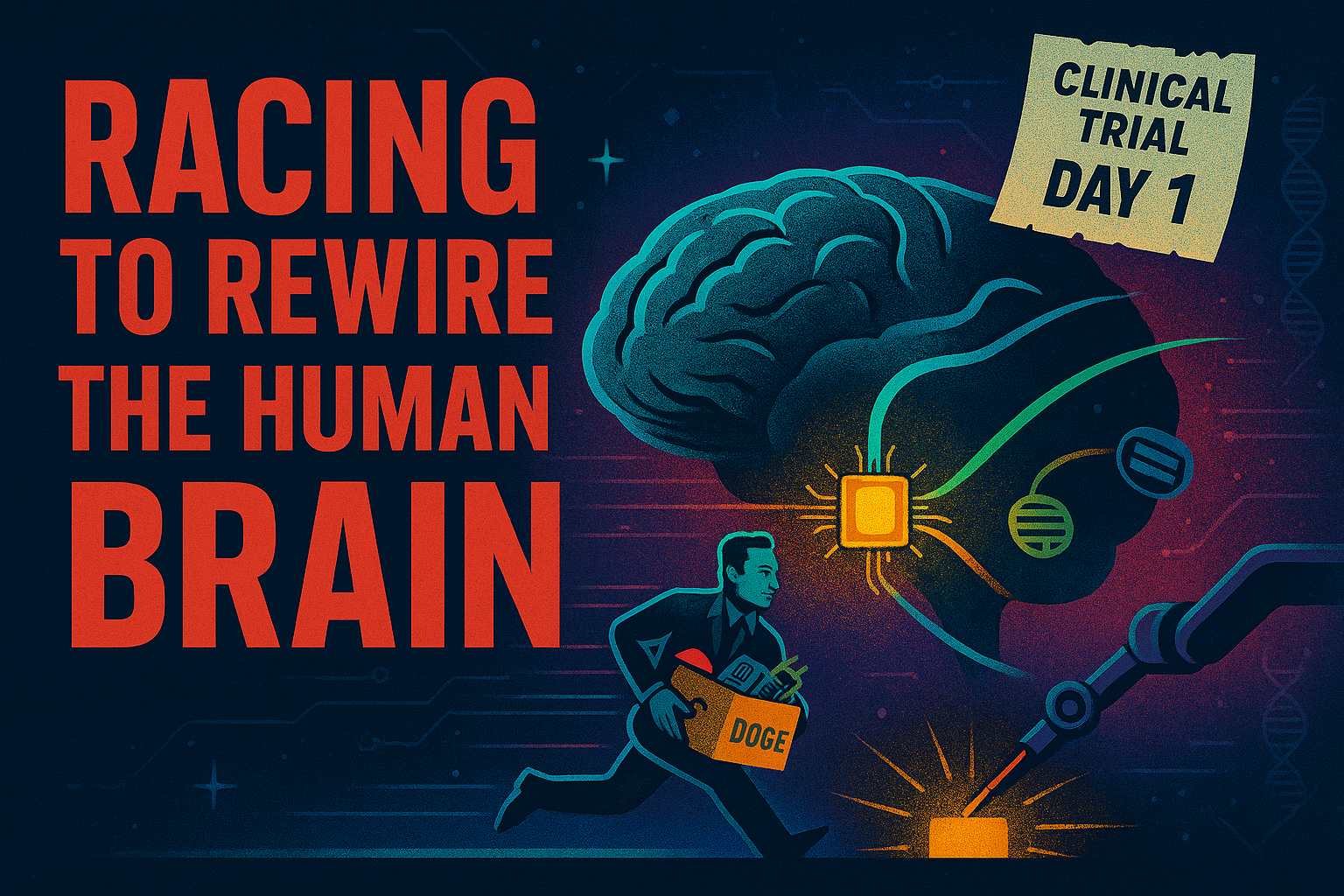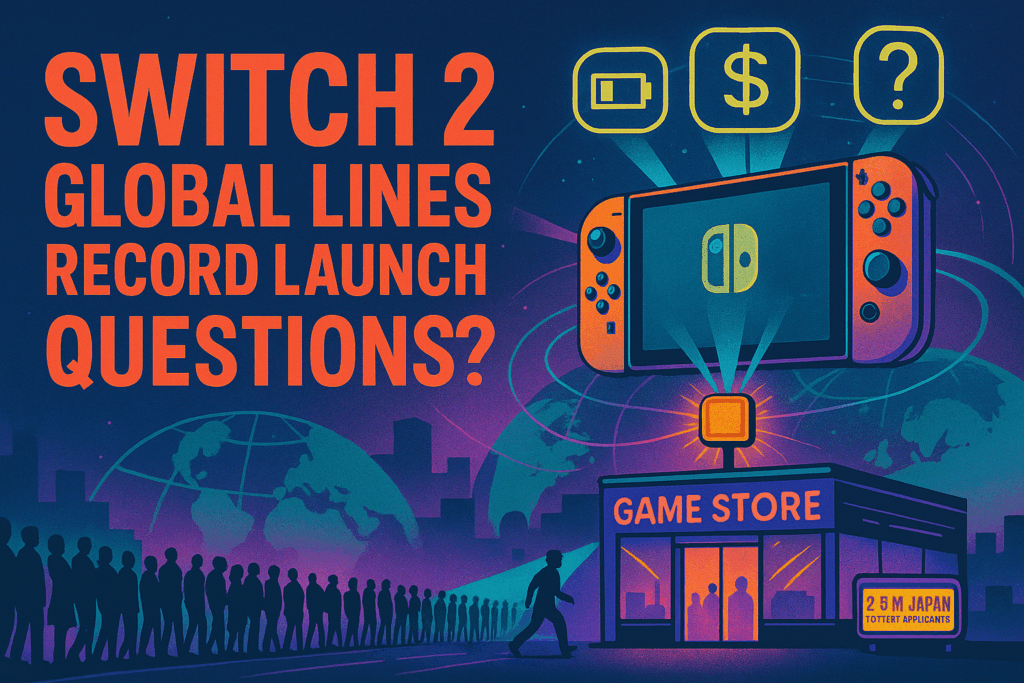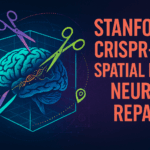At least 100 patients worldwide now have brain implants from Neuralink’s competitors, with Synchron leading the clinical race and Chinese companies accelerating rapidly. Technologyreview The brain-computer interface industry exploded in 2024, attracting $2.3 billion in investment—a 68% increase from 2023— Substackas multiple companies achieved breakthrough regulatory approvals and demonstrated remarkable patient outcomes. BccresearchTechnologyreview While Neuralink captured headlines with its first three human implants, competitors have quietly built substantial clinical evidence, with some approaching commercial launch. Technologyreview The race to restore human capabilities through direct brain interfaces has shifted from science fiction to clinical reality, with profound implications for millions living with paralysis, ALS, and other neurological conditions.
The competitors have arrived in force
The landscape of companies testing brain implants in humans has expanded dramatically beyond early pioneers. Technologyreview Synchron leads with 10 patients implanted across the US and Australia, Reuters +3 having completed their COMMAND trial with zero serious adverse events over 12 months. Neuronewsinternational +2 Their endovascular approach—threading the device through blood vessels like a cardiac stent—eliminates the need for open brain surgery, Reuters completing implantation in a median of just 20 minutes. MassDevice +2
Blackrock Neurotech, the industry veteran with implants in dozens of patients since 2004, MassDevice accumulated over 30,000 patient-days of safety data. Technologyreview Their Utah Array technology powers the BrainGate consortium, Medicaldesignandoutsourcing which published groundbreaking 17-year safety analysis in January 2025 covering 14 patients and 12,203 implant-days. Blackrock Neurotech +3 Chinese companies have emerged as formidable competitors: NeuCyber NeuroTech and the Chinese Institute for Brain Research implanted their semi-invasive Beinao No.1 device in 3 patients, planning 13 total by end of 2025. Reuters NeuroXess in Shanghai achieved a world first by enabling a patient to transmit Chinese New Year greetings through thought alone, demonstrating 71% accuracy in decoding 142 Chinese syllables within just 7 days. Newsfile +2
Paradromics entered human trials in May 2024 with their Connexus system, Quartz +2 boasting the highest bandwidth interface with 421 electrodes per module, scalable to 1,684 total. Prnewswire +3 Precision Neuroscience, founded by former Neuralink executive Benjamin Rapoport, tested their ultra-thin Layer 7 interface in 37 patients and achieved the first FDA 510(k) clearance for a next-generation wireless BCI in 2025. MedTech Dive +3 ONWARD Medical combined BCI with spinal stimulation to restore thought-driven limb movement in paralyzed patients—a historic first. BioSpace +2 Additional players include Johns Hopkins’ CortiCom system, currently recruiting ALS patients, Hopkinsmedicine and Motif Neurotech targeting treatment-resistant depression rather than motor control. Rice News
Technical specifications reveal divergent strategies
The technological approaches vary dramatically in invasiveness and capability. Synchron’s Stentrode contains just 16 platinum electrodes embedded in a nitinol stent, CNBC +2 recording signals through blood vessel walls with 233 Hz bandwidth maintained over 12 months. WikipediaMassDevice Despite lower electrode count, their minimally invasive approach achieved stable performance for cursor control and digital communication. At the opposite extreme, Paradromics’ Connexus delivers 421 platinum-iridium electrodes per cortical module with sub-40 micron diameter, enabling single neuron recording at 100 Mbit/s data transmission via secure infrared link. Prnewswire +3
Precision Neuroscience achieved the highest electrode density with 4,096 electrodes demonstrated in research, Globenewswire though their FDA-cleared device uses 1,024 electrodes on an array thinner than human hair at 1/5th thickness. CNBC +4 Their minimally invasive approach requires only a 400-micron skull incision, inserting over 1,000 electrodes per minute. BioSpace +3 Blackrock’s proven Utah Array uses 96-128 silicon electrodes with 1.5mm penetration depth, Blackrock Neurotech providing superior signal-to-noise ratio for individual neuron recording—the gold standard MassDevice that enabled BrainGate patients to achieve 88 targets per minute in motor control tasks. Technologyreview +2
Power consumption remains constrained to 15-40 milliwatts by regulatory guidelines across all systems. NCBI Wireless capabilities vary: Synchron and Precision use chest-implanted transceivers, Paradromics employs near-infrared optical transmission, while Blackrock maintains wired connections via their CerePort pedestal. Compared to Neuralink’s 1,024 flexible polymer electrodes inserted by surgical robot, Softlabs Group +3 competitors pursue either higher electrode counts (Precision, Paradromics) or radically simplified, less invasive approaches (Synchron). Cas
Clinical trials demonstrate life-changing outcomes
The human trial results reveal remarkable achievements across multiple companies. BrainGate’s speech BCI enabled ALS patient Casey Harrell to communicate at 97% accuracy—better than smartphone voice recognition—using a 125,000-word vocabulary synthesized in his pre-ALS voice. After being unable to speak for years, Harrell cried with joy as words appeared on screen, finally able to communicate with his 5-year-old daughter. Scientific American +4 The system maintained performance across 84 sessions over 32 weeks. news +2
Chinese researchers at NeuroXess achieved breakthrough results in language decoding, reaching 71% accuracy for Chinese syllables with sub-100 millisecond latency. Their 21-year-old patient gained game control within 48 hours and could operate WeChat, e-commerce platforms, and smart home devices with less than 60ms system delay. China DailyInterestingengineering The patient transmitted history’s first thought-based Chinese New Year greeting: “2025 Happy New Year.” China DailyGlobaltimes
Performance metrics across systems show clinically meaningful capabilities: BrainGate achieved 76 targets per minute for precise finger control Nature and 32 words per minute for ALS communication. A paralyzed patient flew a virtual quadcopter at 2.8 rings per minute through thought alone. Nature Synchron’s less invasive approach still enabled hands-free texting, web browsing, and smart home control, with recent integration of Amazon Alexa and Apple Vision Pro expanding possibilities. CNBC
Regulatory breakthroughs accelerate commercialization
The regulatory landscape transformed in 2024-2025 with multiple historic approvals. Precision Neuroscience achieved the first FDA 510(k) clearance for a next-generation wireless BCI electrode array, approved for up to 30 days implantation MedTech Dive versus previous hours-only limitations. GlobenewswireWikipedia ONWARD Medical received FDA De Novo clearance in December 2024 for their ARC-EX spinal stimulation system—the first FDA-approved device specifically for spinal cord injury rehabilitation. Globenewswire
FDA Breakthrough Device Designations proliferated: Blackrock (2021), Medicaldesignandoutsourcing Paradromics (2023 and 2024), Wikipedia Precision Neuroscience (2024), Globenewswire and ONWARD (10 total awards). Prnewswire +2 Synchron holds Investigational Device Exemption approval since 2021, Reuters with their COMMAND trial data supporting preparation for a larger pivotal study. Clinicaltrialsarena +5 The FDA’s Total Product Lifecycle Advisory Program now includes multiple BCI companies, MassDevice providing enhanced regulatory guidance throughout development. MassDevice +5
International progress matches US advances: Chinese companies operate under evolving regulatory frameworks targeting rapid deployment. European CE marking processes advance for several systems. The regulatory momentum suggests first commercial approvals could arrive as early as 2025-2026, with Synchron and Precision best positioned based on clinical data and regulatory status.
Investment surge reflects confidence in near-term commercialization
The financial landscape exploded with $2.3 billion invested across 129 BCI deals in 2024, up 68% from 2023’s $1.4 billion. BccresearchIDTechEx Seven companies exceeded $100 million in single funding rounds. SubstackParadromics Blackrock Neurotech’s $200 million acquisition by cryptocurrency giant Tether in April 2024 marked the largest BCI transaction to date. Pymnts +2 Precision Neuroscience raised $104 million in December 2024’s Series C, Wikipedia bringing total funding above $157 million since 2021. AinvestWikipedia
Notable investors signal mainstream confidence: Jeff Bezos and Bill Gates back Synchron through their investment vehicles. CNBC +5 ARCH Venture Partners, Khosla Ventures, and General Equity Holdings lead major rounds. Strategic partnerships emerged: Paradromics partnered with Saudi Arabia’s NEOM for a BCI Center of Excellence, Prnewswire while ONWARD’s €22.5 million investment from prosthetics leader Ottobock creates manufacturing synergies. OttobockMassDevice
Government support remains substantial through NIH’s BRAIN Initiative, European Innovation Council funding, and historical DARPA investments. Braininitiative The 88% compound annual growth rate suggests funding could exceed $4 billion in 2025, enabling accelerated clinical trials and commercial scaling. Substack
Patients experience profound life improvements
Patient testimonials reveal technology’s human impact beyond clinical metrics. Casey Harrell, unable to speak due to ALS, described his pre-BCI state: “Not being able to communicate is so frustrating and demoralizing. It is like you are trapped.” The BrainGate speech interface changed everything—he cried with joy seeing his thoughts appear as words, finally communicating with his young daughter who had never heard him speak. newsUC Davis
However, research on six seizure-prediction BCI patients revealed complex psychological impacts. While some experienced increased sense of control and self, others reported “radical distress, feelings of loss of control, and rupture of patient identity.” These findings prompted calls for psychological preparedness protocols in future trials.
Patient selection criteria vary by system but generally require stable medical conditions, strong support systems, and realistic expectations. Most trials focus on patients with ALS, spinal cord injury, or brainstem stroke causing severe motor impairment. NeurologyNih The relatively small patient populations—approximately 100 people worldwide with implanted BCIs—makes each participant’s experience invaluable for advancing the field. Technologyreview
Expert opinions reveal cautious optimism
The scientific community expresses measured enthusiasm about recent progress. José del R. Millán from University of Texas warns that invasive implants “will probably only ever reach niche populations of wealthy patients” due to costs and medical risks, advocating for non-invasive alternatives. Nature However, Amy Kruse of Satori Neuro describes current momentum as a “crescendo” after decades of foundational research. STAT
Dr. Benjamin Rapoport of Precision Neuroscience emphasizes unprecedented capabilities: “We can now view human brain activity in ways that have never before been possible.” MassDevice +4 Academic assessments position each technology differently—Jacob Robinson from Rice University calls Paradromics the “highest-bandwidth interface” while noting Synchron’s advantage in avoiding brain surgery entirely. Technologyreview
Bioethicists raise critical concerns about privacy, cognitive liberty, and potential creation of privileged augmented populations. Colorado and Minnesota enacted specific neural data protection laws, with Minnesota implementing criminal penalties for violations. Nih The debate intensifies as BCIs transition from medical devices to potential enhancement technologies.
Market analysis projects explosive growth ahead
Market projections vary but unanimously predict dramatic expansion. Conservative estimates show growth from $1.5 billion (2023) to $3.1 billion (2030) at 10.3% CAGR. Globenewswire Aggressive projections reach $12.4 billion by 2034 at 17.35% CAGR. Bccresearch +4 Non-invasive BCIs currently dominate with 81.86% market share, though invasive systems grow faster at 11.6% CAGR. PrecedenceresearchGrandviewresearch
Healthcare applications command 57.5% market share, Grandviewresearch with research/education as the fastest growing segment. North America leads with 39.84-48.43% share, while Asia-Pacific emerges as the fastest growing region at 9.5% CAGR, BccresearchPrecedenceresearch driven by Chinese government support and rapid clinical deployment. Grandviewresearch
The competitive landscape reveals distinct positioning: Synchron leads in clinical progress and safety data with 10 patients and zero serious adverse events. NeuronewsinternationalClinicaltrialsarena Neuralink maintains the highest public profile and most advanced electrode technology. Wikipedia Paradromics offers maximum bandwidth for complex applications. Technologyreview Precision achieved first commercial clearance with reversible implantation. Globenewswire Blackrock leverages 20 years of safety data toward commercialization. MassDeviceMedicaldesignandoutsourcing
Future plans target diverse applications
Company roadmaps converge on 2025-2026 for major milestones. Paradromics plans multiple surgeries and late-2025 clinical trial launch targeting speech restoration through neuron-level decoding. MassDevice +2 Precision expands research programs while pursuing full commercial clearance. Globenewswire Synchron prepares for large-scale pivotal trials with 120+ interested medical centers. ReutersMassDevice
Technology development focuses on next-generation materials including graphene electrodes for superior conductivity and reduced tissue pressure. Wireless systems eliminate external connections while miniaturization approaches cellular scale. Technology Networks AI integration enables real-time adaptation to user intentions and cross-platform compatibility.
Beyond medical applications, companies explore gaming integration with Valve investigating BCIs for metaverse applications. World Economic Forum Brain-to-brain communication research advances toward direct thought transfer. SpringerOpen Military applications include cognitive enhancement and pilot state monitoring. Consumer applications could emerge by 2027-2028 for non-invasive systems.
Safety considerations and ethical frameworks evolve
Published safety data provides reassurance: Synchron reported zero device-related serious adverse events over 12 months. Neuronewsinternational +2 BrainGate’s 17-year analysis documented 68 device-related adverse events across 12,203 patient-days—mostly minor skin irritation. PubMed +2 No competitor reported serious safety issues in 2024-2025 trials.
Ethical frameworks struggle to keep pace with technological capabilities. Key concerns include protecting neural data privacy, ensuring informed consent for irreversible procedures, preventing coercive use, and maintaining equitable access. Taylor & Francis The potential for cognitive enhancement beyond medical restoration raises questions about creating privileged augmented populations.
State-level legislation in Colorado and Minnesota establishes precedents for neural data protection. Nih International bodies develop guidelines for responsible development. The transition from purely medical devices to potential enhancement technologies demands new ethical frameworks balancing innovation with human rights protection.
Conclusion
The brain-computer interface industry stands at an inflection point where decades of research crystallize into life-changing therapies. WikipediaSTAT While Neuralink captures public imagination, competitors like Synchron, Precision Neuroscience, and emerging Chinese companies demonstrate equally impressive achievements through differentiated approaches. Technologyreview The $2.3 billion invested in 2024 signals confidence that commercial BCIs will reach patients within 2-3 years. BccresearchSubstack
The diversity of technological approaches—from Synchron’s minimally invasive stent to Paradromics’ high-bandwidth arrays—ensures solutions for varied patient needs and risk tolerances. First commercial approvals appear imminent, with multiple companies holding breakthrough designations and completing successful trials. As BCIs transition from laboratory curiosities to clinical realities, they promise to restore communication, movement, and independence to millions living with neurological conditions. Built In +2 The race to rewire the human brain has truly begun, with benefits already flowing to pioneering patients









![Meta's $300 million gamble reshapes the AI talent wars Meta has launched the most aggressive talent acquisition campaign in technology history, offering individual compensation packages up to $300 million over four years to elite AI researchers. CNBC +7 This unprecedented strategy, coupled with $60-65 billion in infrastructure investments for 2025, represents Mark Zuckerberg's all-in bet to transform Meta from an AI follower into the leader in the race toward superintelligence. Data Center Dynamics +5 The campaign has successfully recruited dozens of top researchers from OpenAI, Google DeepMind, and Apple, while fundamentally disrupting compensation norms across the entire AI industry and raising critical questions about talent concentration and the future of AI development. CNBC +8 The $300 million figure decoded: Individual packages, not aggregate spending The widely reported "$300 million AI brain drain" figure represents individual compensation packages for elite AI researchers over four-year periods, not Meta's total spending on talent acquisition. Gizmodo +3 According to Fortune's July 2025 reporting, "Top-tier AI researchers at Meta are reportedly being offered total compensation packages of up to $300 million over four years, with some initial year earnings exceeding $100 million." Fortune Yahoo Finance These packages primarily consist of restricted stock units (RSUs) with immediate vesting, rather than traditional signing bonuses, as Meta CTO Andrew Bosworth clarified: "the actual terms of the offer wasn't a sign-on bonus. It's all these different things." CNBC +2 The compensation structure includes base salaries up to $480,000 for software engineers and $440,000 for research engineers, Fortune supplemented by massive equity grants and performance bonuses. Fortune SmythOS Specific examples include Ruoming Pang from Apple receiving $200+ million over several years Fortune and Alexandr Wang from Scale AI receiving $100+ million as part of Meta's $14.3 billion investment in Scale AI. Fortune +3 OpenAI CEO Sam Altman confirmed these figures on the "Uncapped" podcast, stating Meta made "giant offers to a lot of people on our team, you know, like $100 million signing bonuses, more than that (in) compensation per year." CNBC +6 This compensation strategy emerged after Meta's Llama 4 model underperformed expectations in April 2025, prompting Zuckerberg to take personal control of recruitment. CNBC +3 The CEO maintains a "literal list" of 50-100 elite AI professionals he's targeting, making direct phone calls to recruit them. Fortune +5 While not every hire receives nine-figure packages—typical offers range from $10-18 million annually—the peak compensation levels have redefined industry standards and forced competitors to dramatically increase their retention spending. TechCrunch Meta raids the AI elite: Key acquisitions from competitors Meta's talent acquisition campaign has systematically targeted the architects of competitors' most successful AI models, with particular focus on researchers with expertise in reasoning models, multimodal AI, and foundation model training. SmythOS Fortune The company has successfully recruited 11+ researchers from OpenAI, including several co-creators of ChatGPT and the o-series reasoning models. South China Morning Post +4 Notable acquisitions include Shengjia Zhao, named Chief Scientist of Meta Superintelligence Labs in July 2025, who co-created ChatGPT, GPT-4, and all mini models; CNN Trapit Bansal, a key contributor to OpenAI's o1 reasoning model who pioneered reinforcement learning approaches; TechCrunch TechCrunch and Hongyu Ren, co-creator of GPT-4o, o1-mini, and o3. CNBC +2 From Google DeepMind, Meta secured Jack Rae, the pre-training tech lead for Gemini who also led development of Gopher and Chinchilla; Pei Sun, who led post-training, coding, and reasoning for Gemini after creating Waymo's perception models; Fortune CNBC and multiple other Gemini contributors. CNBC Silicon UK The Apple raid centered on Ruoming Pang, head of Apple's AI foundation models team who led Apple Intelligence development, along with three senior team members including distinguished engineer Tom Gunter. MacDailyNews +4 These acquisitions follow a clear strategic pattern: Meta is targeting researchers with proven expertise in areas where it has fallen behind, particularly reasoning models and multimodal AI. SmythOS The recruits often move as cohesive teams—for instance, the OpenAI Zurich office researchers Lucas Beyer, Alexander Kolesnikov, and Xiaohua Zhai all joined Meta together. TechCrunch TechCrunch This team-based approach accelerates Meta's ability to replicate successful research methodologies while disrupting competitors' ongoing projects. The talent flow has created significant disruption at source companies. OpenAI's Chief Research Officer Mark Chen described the exodus in an internal memo: "I feel a visceral feeling right now, as if someone has broken into our home and stolen something." Yahoo! +2 Apple's AI strategy faced major setbacks after losing its foundation models leadership, forcing a reorganization under Craig Federighi and Mike Rockwell. MacRumors Superintelligence ambitions drive massive infrastructure buildout Meta's creation of the Meta Superintelligence Labs (MSL) in June 2025 represents a fundamental reorganization of its AI efforts under unified leadership. Led by Alexandr Wang as Chief AI Officer and Nat Friedman heading AI products and applied research, MSL consolidates all AI research with the explicit goal of achieving "personal superintelligence for everyone." CNBC +2 Zuckerberg's internal memo declared: "As the pace of AI progress accelerates, developing superintelligence is coming into sight. I believe this will be the beginning of a new era for humanity." CNBC +2 The infrastructure investments supporting this ambition dwarf anything previously attempted in corporate AI research. Meta committed $60-65 billion for 2025 alone, representing a 50% increase from 2024, with plans for "hundreds of billions of dollars" in coming years. Data Center Dynamics +7 The company is constructing two revolutionary data centers that abandon traditional designs for speed-focused "tent" infrastructure. The Prometheus Cluster in Ohio will provide 1 gigawatt of capacity by 2026, featuring on-site natural gas generation through two 200MW plants to bypass grid limitations. The Hyperion Cluster in Louisiana represents an even more ambitious undertaking: a 2GW facility scaling to 5GW, covering an area "the size of most of Manhattan" with a $10 billion investment on 2,250 acres. Opportunity Louisiana +5 Meta's technical infrastructure includes 1.3+ million GPUs targeted by end of 2025, utilizing prefabricated power and cooling modules for rapid deployment and sophisticated workload management to maximize utilization. PYMNTS +3 The company has shifted its research focus from traditional AGI to what Chief AI Scientist Yann LeCun calls "Advanced Machine Intelligence" (AMI), arguing that human intelligence is specialized rather than generalized. Columbia Engineering AI Business Current research priorities span computer vision (Perception Encoder, Meta Locate 3D), foundation models (continued Llama development despite setbacks), world models for predicting action outcomes, and collaborative AI for multi-agent reasoning. Meta meta The Llama 4 "Behemoth" model's failure—attributed to chunked attention creating blind spots and economically unviable inference—led to a strategic pivot toward smaller, more efficient variants while the new superintelligence team addresses fundamental research gaps. CNBC +4 The talent war escalates: Compensation packages reach athlete-level extremes The AI talent war has created compensation dynamics unprecedented in technology history, with packages now exceeding those of professional athletes and Wall Street executives. Meta's aggressive offers have forced industry-wide salary inflation, with typical AI researcher packages at major labs now ranging from $2-10 million annually. Ainvest +4 OpenAI responded to defections by jumping stock compensation 5x to $4.4 billion company-wide, offering $2+ million retention bonuses with one-year commitments and $20+ million equity deals to prevent key departures. Fortune +3 Despite Meta's financial firepower, retention data reveals that money alone doesn't guarantee loyalty. Meta maintains only a 64% retention rate, the lowest among major AI labs, while experiencing 4.3% annual attrition to competitors. SmythOS The Register In contrast, Anthropic achieves an 80% retention rate with more modest compensation ($311K-$643K range) by emphasizing mission-driven culture and researcher autonomy. The Register +6 The data shows an 8:1 ratio of OpenAI departures favoring Anthropic over the reverse, suggesting that purpose and product quality matter as much as pay. signalfire Analytics India Magazine The compensation arms race extends beyond individual packages to strategic "acqui-hires." Google executed a $2 billion deal to bring back Noam Shazeer and the Character.AI team, while Microsoft absorbed most of Inflection AI for $650 million. Fortune Fortune These deals allow companies to acquire entire teams while potentially avoiding regulatory scrutiny of traditional acquisitions. Geographic concentration intensifies the competition, with 65% of AI engineers located in San Francisco and New York. signalfire However, emerging hubs like Miami (+12% AI roles) and San Diego (+7% Big Tech roles) are beginning to attract talent with compensation at 83-90% of Bay Area levels. Fortune The elite talent pool remains extremely constrained, with experts estimating only 2,000 people worldwide capable of frontier AI research, driving the extreme premiums for proven expertise. The Register Fortune Industry experts divided on Meta's bold strategy Industry analysis reveals deep divisions about Meta's approach and its implications for AI development. SemiAnalysis characterizes the compensation packages as making "top athlete pay look like chump change," with typical offers of "$200M to $300M per researcher for 4 years" representing "100x that of their peers." CFRA analyst Angelo Zino views the acquisitions as necessary long-term investments: "You need those people on board now and to invest aggressively to be ready for that phase of generative AI development." Yahoo! CNBC Academic researchers express concern about the broader implications. MIT's Neil Thompson and Nur Ahmed warn that by 2020, "nearly 70% of AI Ph.D. holders were recruited by industry, up from only 21% in 2004," creating a troubling brain drain that "leaves fewer academic researchers to train the next generation." MIT Sloan Brookings They argue this concentration could "push to the sidelines work that's in the public interest but not particularly profitable," including research on AI bias, equity, and public health applications. MIT Sloan Competitors have responded with varying strategies. Google relies on personal intervention from leadership, with co-founder Sergey Brin "personally calling an employee and offering them a pay rise to stay," while maintaining advantages in computing power and proprietary chips. Fortune +2 Microsoft has "tied its AI fate to OpenAI" while building in-house capabilities, even reviving the Three Mile Island nuclear plant to power AI operations. PYMNTS OpenAI faces the most direct impact, with Sam Altman criticizing Meta's approach as "distasteful" and arguing that "missionaries will beat mercenaries." CNBC +6 The venture capital community sees Meta's strategy accelerating market consolidation. HSBC Innovation Banking reports that "42% of U.S. venture capital was invested into AI companies in 2024," EY with compensation inflation making it increasingly difficult for startups to compete. Menlo Ventures' Tim Tully notes that "Stock grants for these scientists can range between $2 million to $4 million at a Series D startup. That was unfathomable when I was hiring research scientists four years ago." Fortune Policy experts worry about innovation concentration. The Brookings Institution recommends "direct support to keep [academic researchers] from leaving for industry" and "more open immigration policies" to broaden the talent pool. Brookings Some propose international collaboration similar to CERN to ensure more distributed AI development and prevent unhealthy concentration of capabilities in a few corporations. MIT Sloan Conclusion Meta's $300 million talent acquisition gambit represents more than aggressive recruitment—it's a fundamental bet that concentrating elite AI talent through unprecedented compensation can overcome technical disadvantages and establish superintelligence leadership. Early results show mixed success: while Meta has successfully recruited dozens of top researchers and committed massive infrastructure investments, the company still faces the lowest retention rate among major AI labs and continued technical challenges with its foundation models. The Register +2 The strategy has irrevocably transformed the AI talent landscape, normalizing eight and nine-figure compensation packages while accelerating the concentration of expertise in a handful of well-funded laboratories. Fortune Axios This concentration may accelerate progress toward AGI but raises critical questions about research diversity, academic sustainability, and the public interest in AI development. As one MIT researcher noted, industry benchmarks now drive the entire field's research agenda, potentially sidelining work on bias, equity, and public applications. Meta's ultimate success will depend not just on financial resources but on its ability to create a mission-driven culture that retains talent and translates unprecedented human capital investment into breakthrough capabilities. Computerworld +2 With competitors matching compensation while maintaining advantages in culture (Anthropic), infrastructure (Google), or partnerships (Microsoft), Meta's superintelligence ambitions face significant challenges despite unlimited financial backing. The Register The AI talent wars have entered a new phase where money is necessary but insufficient—and where the concentration of capabilities in corporate hands may fundamentally reshape not just the industry but the trajectory of human technological development.](https://news.envychip.com/wp-content/uploads/2025/07/Gwum3dibgAYIuX--480x480.jpeg)

